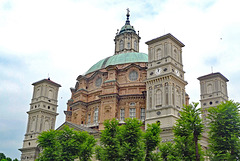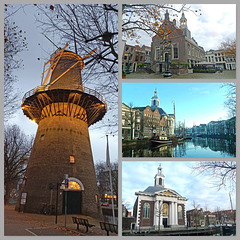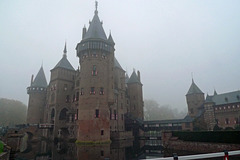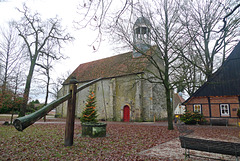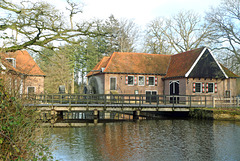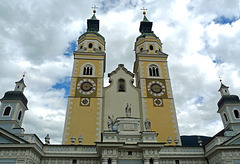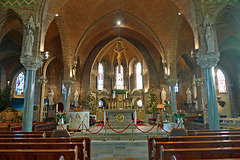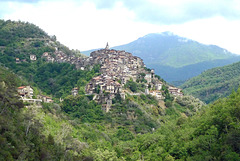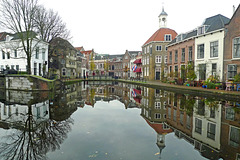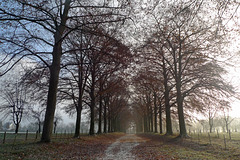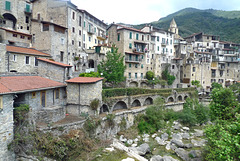Jaap van 't Veen's photos
Italia - Pontebba, Santa Maria Maggiore
| |
|
|
|
The historically most important church in the area is the parish church of Santa Maria Maggiore in Pontebba. The little chapel - most probably from the 12th century – was rebuilt in gothic styli in 1504 by architect Johann Komauer. A number of changes and additions had been made over the years. The present church - originally San Antonio Chapel - was built in 1697.
The highlight of the church is its famous ‘Flügelaltar’ (winged altarpiece). This wonderful wooden altar dates back till 1517, with carved, painted and gilded parts. The altar reproduces the incoronation of the Virgin Mary in the central scene and on the side doors at the front, evangelic scenes. The winged altarpiece has a height of 7,50 meters.
Nederland - Delft, Nieuwe Kerk
| |
|
|
|
The city council of Delft decided to build the Nieuwe Kerk (New Church). The city already had a church - nowadays known as the Oude Kerk (Old Church) - which is why it is called the Nieuwe Kerk .
In the year of 1381, a wooden temporary building - dedicated to Mary - was first erected and a few years later a stone late Gothic cross basilica was built around it, which was dedicated to St. Ursula.
As with so many churches, construction proceeds in stages. The tower was completed in 1496, consisting of a square base, above it two octagons and an apple-shaped spire. The Nieuwe Kerk was finally completed in 1655, having already endured a devastating city fire, the Delft Thunderclap (a gunpowder explosion) and various renovations.
In 1872, lightning struck the spire again. Some three years later, the famous Dutch architect Pierre Cuypers had a new one put on it. Wit a height of 108 meters it is the second highest church tower in the Netherlands.
The most prominent monument in the church is the tomb of Willem van Oranje, the Dutch ‘Father of the Fatherland’. The mausoleum was crafted by architect and sculptor Hendrick de Keyser and his son Pieter. Since the death of Willem van Oranje, the last resting place of members of the House of Oranje-Nassau has traditionally been the family vault in the Nieuwe Kerk in Delft. The latest are Queen Juliana and her husband Prince Bernhard in 2004.
The church nowadays houses an exhibition and video presentations on the history of the Nieuwe Kerk and the Dutch royal family. The church can be visited for a fee.
Nederland - Schiedam, De Kameel
| |
|
|
|
Schiedam is home to the seven largest windmills in the world. Once there were more than 30 mills in the city. The majority of the so called ‘brandersmolens’ (malt mills) ground grain for the distilleries. To catch enough wind within the built-up area, and for greater storage and production capacity, the mills grew to be the tallest in the world. They have been joined in this century by two new mills, bringing the total number of malt mills to seven. These remaining ‘Giants of Schiedam’ are still characteristic of the city.
De Kameel (The Camel) originally was built in 1715; about 30 metres east of where the rebuilt windmill along the river Schie nowadays is located. The mill served as a malt mill until the early morning of 20 March 1865. On that day the mill lost its rods, iron shaft and cap in a storm in a storm. After a partial repair the mill served as a steam sawmill for several years. Three years later the remains of De Kameel were demolished after a fire.
Of all the mills the city has had and De Kameel was the most visible from the city centre. Rebuilding it in its original location was not feasible, as the turning basin in the river Schie was moved in 1960 to build a new access road with a bridge to the city centre. A site nearby was chosen, with the mill built halfway into the water of the Schie. After years of preparation, the Stichting De Schiedamse Molens started rebuilding the mill in November 2008.
The mill measures about 30.5 meters to the top. This makes De Kameel the smallest of the existing or rebuilt Schiedam mills. Since Saturday 14 May 2011 - Dutch National Mills Day - the rebuilt mill officially has been grinding again.
Nederland - Delft, Klaeuwshofje
| |
|
|
|
Delft is one of the cities in the Netherlands that has a number of so called hofjes . A hofje is a Dutch word for a courtyard with almshouses around it. They have existed since the Middle Ages. Characteristically, almost all are built around an inner garden.
The Klaeuwshofje is named after the brewery “In De Claeuw”. It was founded in 1605 by the Uyttenhage van Ruyven couple. Often, hofjes are founded as inheritance of his or her founder, which is not the case with The Klaeuwshofje . In fact, it was built when the couple was still alive.
The Klaeuwshofje is one of the more hidden courtyards in Delft. The houses were intended for unmarried or widowed Catholic women. After a renovation, nowadays the inhabitants have double the amount of space; an improvement over the original sizes of the houses.
Nederland - Schiedam, De Palmboom
| |
|
|
|
Schiedam is home to the seven largest windmills in the world. Once there were more than 30 mills in the city. The majority of the so called 'brandersmolens' (malt mills) ground grain for the distilleries. To catch enough wind within the built-up area, and for greater storage and production capacity, the mills grew to be the tallest in the world. They have been joined in this century by two new mills, bringing the total number of malt mills to seven. These remaining ‘Giants of Schiedam’ are still characteristic of the city.
Windmill De Palmboom (The Palm Tree) is dating back to the year of 1781. The mill was used as a malt mill for the distilleries in Schiedam. The windmill was destroyed by a fire in 1901 and after that only two floors were used as storage space.
In 1993 a restoration and reconstruction started and the stage mill was renamed De Nieuwe Palmboom . Till 2018 it was used as a mill museum. It got back its original name and nowadays functions as office space and houses a documentation center.
The windmill in the background is ‘De Noord’ - one of the highest windmills in the world - nowadays housing a restaurant.
Italy - Vicoforte, Basilica della Natività di Mari…
| |
|
|
|
The Basilica della Natività di Maria Santissima (Basilica of the Nativity of Maria Santissima), commonly called “Sanctuary of Vicoforte” is one of the most important churches in Piedmont.
The huge complex has its origins in a medieval sanctuary. The story tells that an errant shot by a hunter in the year of 1592 hit a pillar of the Virgin Mary in a shrine that happened to be very important to pilgrims, and he was so repentant that he put down his gun and raised money for the repair of the pillar.
In a few years the place became a destination for increasingly frequent pilgrimages. In 1596 Duke Carlo Emanuele I of Savoy who, in 1596, commissioned the construction of a large sanctuary, but was never finished. It was not until 1728 when construction was resumed by architect and engineer Filippo Juvarra. Above the Mannerist sandstone base, the drum was quickly built, and the dome, which was finished in 1732.
The basilica has - with more than 6.000 square meters - the largest elliptical cupola in the world, which has major and minor diameters of 36 and 25 meters. The fresco decorations were completed in 1752.
During our visit to Vicoforte, the basilica was closed. Unfortunately, we could only see (and photograph) the dome through a gate.
Nederland - Schiedam
| |
|
|
|
Schiedam was founded in 1230 when the local river the “Schie”, had a dam built on it to protect the existing polders from the North Sea. The dam brought much trade to the area, due to goods being brought to, or transported from the area, to other Dutch towns. The village quickly grew and in 1275 the village received city rights.
Large parts of Schiedam were destroyed by fire in the year 1428, due to most of the buildings being made of wood. But the city was rebuilt and again, flourished. During the 1700’s the production of jenever (gin) started. Soon there were many distilleries in Schiedam. From dozens of distilleries the jenever was traded to many parts of the world and brought great wealth to the city. The gin industry gave the city its nickname 'Black Nazareth'.
Schiedam is known for its historical center with picturesque canals, lined with former warehouses, distilleries and the tallest windmills in the world.
Nederland - Haarzuilens, Kasteel de Haar
| |
|
|
|
Kasteel de Haar (The Haar Castle) is one of the most visited castles in the Netherlands. Originally it was named Het Huys te Haer . However the current Gothic fairy-tale castle was built between 1892 and 1912 with incorporation of the large 15th century ruins of the original castle.
Kasteel de Haar was first mentioned in 1391 along a blind arm of the river Rhine. Originally the owner was a member of the “Van de Haar” family. In 1449 the castle became property of the “Van Zuylen” family through the marriage between Josyna van de Haar and Dirk van Zuylen. Several families owned the castle until 1890 when baron “Etienne van Zuylen van Nijevelt”, inherited Kasteel de Haar (by then the castle had been in a ruinous and desolate state for almost two centuries). In 1887 Etienne had married the French baroness Helene de Rothschild (member of the extremely wealthy De Rothschild family), which enabled him to rebuilt the castle.
In 1892 the rebuilding of Kasteel de Haar started under the direction of the well known Dutch architect Cuypers. It's his interpretation of the ‘medieval’ castle one can see today. The interior was rebuilt in a un-Dutch luxurious style, it was equipped with electricity and the former courtyard, covered with a large roof, was turned into an imprerssive central hall. The interior is luxuriously decorated with a large but incoherent collection of valuable antiques from all over the world.
In 2000 the ownership of the castle was transferred to “Stichting Kasteel de Haar”. This foundation worked to transform the place into a museum and event center. The castle has 200 rooms - although not all of them can be visited. A couple of rooms are arranged with realistic displays to show how the castle would have looked like in his days of parties. Nowadays Kasteel de Haar is (almost) open daily for visitors.
Italy - Apricale, Chiesa della Purificazione di Ma…
| |
|
|
|
The Chiesa della Purificazione di Maria Vergine (Church of the Purification of the Virgin Mary) is the parish church of Apricale. The church - built in the 13th century - is located in the heart of the centre of the perched medieval village.
The church was restored several times and today it appears in baroque style with a neo-Romanesque façade. The interior is composed of three naves divided in two rows of four pillars each. Inside the vaults, in 1904, painter Leonida Martini frescoed floral patterns and images of saints.
The bell tower of the church is remarkable with a bicycle facing upwards. This contemporary artwork of Sergio Bianco symbolizes the power of non-gravity. I must admit that I had not seen the artwork during my visit. But a photo of Nora Caracci pointed me to this unusual tower.
Nederland - Het Stift, Stiftskerk
| |
|
|
|
Het Stift - a unique place in Twente - is an age-old protected townscape nearby Weerselo. It is over 800 years since a community was founded here by ‘Hugo van Buren’. The commune was transformed into a Benedictine double monastery that housed both monks and nuns in 1152. A century later, the last monks left Weerselo, but the unmarried ladies of nobility remained.
The central building at Het Stift is without any doubt the Stiftskerk . Not only because of its size, age and religious significance, but also because it has functioned actively throughout all the centuries: in the Middle Ages as a monastery and parish church, then as Stiftskerk of the Reformed congregation. In the latter capacity, it still functions today.
Despite its use as part of a monastery and stift inhabited by nobility, the church is small and consists of one aisle only. It is probable that the walls of irregular pieces of natural stone are from the 14th century. Originally, the church was one trave longer. In 1523 a fire destroyed the church, and when it was repaired the nave was shortened and given a new front. The buttresses, the vaults and the upper parts of the wall date from this period as well.
Today, the Stiftskerk is used for weddings, concerts, funerals and church services.
Nederland - Denekamp, Watermolen Singraven
| |
|
|
|
'Singraven' is an estate near the town of Denekamp. It includes a manor, a garden, a water mill, a carriage house and a number of farmhouses. The estate offers a versatile landscape with forests, lanes, fields, meadows, marshes and the ever-present river Dinkel.
The water mill has been part of Landgoed Singraven (Singraven Estate) since 1448. The mill consists of an oil mill (no longer in operation and partly demolished, nowadays housing a restaurant), a corn mill and a saw mill. The corn mill and saw mill are still in operation and can be visited. The mill is run - mostly on Saturdays during summer time - by volunteer millers.
Watermolen Singraven is the last water-driven undershot sawmill in the Netherlands. Its water supply comes from the small river Dinkel, which rises in the town of Holtwyck in Nordrein Westfalen (Germany).
The mill has three water wheels, each with a diameter of 5.5 metres. The left wheel against the restaurant is from the former oil mill. The oil mill was demolished in the early 20th century, so the wheel is the only remaining part. The middle wheel is from the corn mill and the right wheel from the sawmill.
Italy - Brixen Cathedral
| |
|
|
|
The ‘Dom Mariae Aufnahme in den Himmel und St. Kassian’ (Cathedral of Santa Maria Assunta and San Cassiano) is the largest church in Brixen, once belonging to the powerful Principality of Brixen, nowadays the diocese of Bolzano-Brixen. Although Bolzano is currently the city of residence of the bishop, the most important church in South Tyrol is still the cathedral in Brixen.
The cathedral is dating back to the late 10th century when the main building and its annexes were erected. A fire destroyed the church in 1174. The new Romanesque-gothic building was rebuilt in the baroque style during the period of 1745 to 1755.
The cathedral’s two towers are the landmark of the city of Brixen. The interior of the cathedral is a masterpiece of historical and artistic value. Its wide domed nave is decorated with rich marble and stucco. The main altar has a very striking altarpiece, but the decorative highlight is the fresco on the ceiling.
Nederland - Denekamp, Sint-Nicolaaskerk
| |
|
|
|
The history of the Sint-Nicolaaskerk (Church of Saint Nicholas) is dating back to the year of 1276, when Denekamp was mentioned as a parish for the first time. The church is one of the few religious buildings erected in the region of Twente in the 13th century that is still largely preserved.
The medieval part of the present church consists of a single-bay. As far as this region of the Netherlands is concerned it is the oldest preserved single-bay church, though no longer completely intact.
The medieval parts were built of sandstone from nearby Bentheim. The tower was built against the church in the second half of the 15th century (or early 16th century). Later there were many more enlargements, the last one started in 1910 with the construction of a new transept and choir and apse, which were built with bricks. Architect ‘Te Riele’ also gave the tower - which had been fully closed - an entrance in a pseudo-Romanesque style.
After the reformation the church was used by the protestant minority for about two centuries. In 1809 King ‘Lodewijk Napoleon’ gave back the church to the Catholics. The church is still used for services.
Nederland - Denekamp, Huis Singraven
| |
|
|
|
'Singraven' is an estate near the town of Denekamp. It includes a manor, a garden, a water mill (dating back to1448), a carriage house (1868) and a number of farmhouses. The estate offers a versatile landscape with forests, lanes, fields, meadows, marshes and the ever-present river Dinkel.
Huis Singraven (Singraven Manor) has a rich history. In 1381, the estate is first mentioned as an agricultural farmstead Hof ten Singraven ; property of the bishop of Utrecht. In 1398 the house came into the possession of a family who fortified it into a manor in 1415. After being owned by several families, the estate eventually came into the possession of Willem Frederik Jan Laan. This private owner was the last resident of Huis Singraven .
Mr Laan commissioned several substantial renovations and restorations, including a neo-classical façade. During the period he lived in the house, he amassed a huge art and antiques collection. Mr Laan gave ownership of the estate to the “Edwina van Heek Foundation” in 1956 under the condition that everything should continue to exist in its original state.
Huis Singraven has limited opening hours and can only be visited by a guided tour.
Italy - Apricale
| |
|
|
|
The first written documents about Apricale date back to 1267. The history of Apricale, however, officially begins about two centuries before with the foundation of the castle, wanted by the accounts of Ventimiglia. The place, chosen as a defensive outpost, is called Apricus; around the castle the village develops.
In 1270 Apricale entered the fiefdom of the Doria of Dolceacqua, passing definitively into the sphere of influence of the Republic of Genoa. In the 18th century, Genoa’s difficulties are reflected in Apricale: wars and economic crisis, but also frosts, droughts and famines make it the darkest century in the history of the village, until the French occupation in 1794. In 1815, according to the dictates of the Congress of Vienna, it became part of the kingdom of Sardinia.
Apricale comes from “apricus”, which in Latin means “exposed to the sun”, and in fact, the village is all built on the southern side of the hill. Coming from the Nervia Valley the village seems to be a waterfall of houses surrounded by forested hills. The little mountain village itself is a labyrinth of houses and alleyways.
Nederland - Schiedam
| |
|
|
|
Schiedam was founded in 1230 when the local river the “Schie”, had a dam built on it to protect the existing polders from the North Sea. The dam brought much trade to the area, due to goods being brought to, or transported from the area, to other Dutch towns. The village quickly grew and in 1275 the village received city rights.
Large parts of Schiedam were destroyed by fire in the year 1428, due to most of the buildings being made of wood. But the city was rebuilt and again, flourished. During the 1700’s the production of jenever (gin) started. Soon there were many distilleries in Schiedam. From dozens of distilleries the jenever was traded to many parts of the world and brought great wealth to the city. The gin industry gave the city its nickname 'Black Nazareth'.
Schiedam is known for its historical center with picturesque canals, lined with former warehouses, distilleries and the tallest windmills in the world.
Nederland - Eijsden
| |
|
|
|
Kasteel Eijsden (Castle Eijsden) is a Dutch state monument. The castle is located on the banks of the river Meuse nearby where the small river Voer flows into it.
The picture shows a long driveway with stately trees on the east side of the complex, leading up to a Maria chapel.
Italy - Rochetta Nervina
| |
|
|
|
Archaeological findings testify that the area where Rocchetta stands today has been continuously inhabited since Roman times. During medieval times it was a place through which pilgrims passed on their way from Lower Piedmont through the Nervia Valley: many of the religious buildings in the area served as hospices.
Politically it belonged to an important strategic area called the “County of Nice”. The history Rochetta Nervina is one of a borderland, constantly harassed by fighting and raids between its inhabitants and its neighbours, particularly the Dorias of Dolceacqua .
Today Rocchetta Nervina - with less than 300 inhabitants - still has its medieval appearance, located on the banks of the river Barbaira. The little village is well known for its pools of water (laghetti di Rochetta) in that river (PiP3).
Jump to top
- ipernity © 2007-2024
- Help & Contact
|
Club news
|
About ipernity
|
History |
ipernity Club & Prices |
Guide of good conduct
Donate | Group guidelines | Privacy policy | Terms of use | Statutes | In memoria -
Facebook
Twitter






